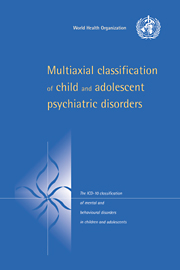 Multiaxial Classification of Child and Adolescent Psychiatric Disorders
Multiaxial Classification of Child and Adolescent Psychiatric Disorders Book contents
- Frontmatter
- Contents
- Introduction
- Axis One (Clinical psychiatric syndromes), page 11 to 98
- (Clinical psychiatric syndromes), page 99 to 176
- Axis Two (Specific disorders of psychological development)
- Axis Three (Intellectual level)
- Axis Four (Medical conditions from ICD-10 often associated with mental and behavioural disorders)
- Axis Five (Associated abnormal psychosocial situations)
- Axis Six (Global assessment of psychosocial disability)
- Acknowledgements
- Index
Axis Six - (Global assessment of psychosocial disability)
Published online by Cambridge University Press: 05 November 2011
- Frontmatter
- Contents
- Introduction
- Axis One (Clinical psychiatric syndromes), page 11 to 98
- (Clinical psychiatric syndromes), page 99 to 176
- Axis Two (Specific disorders of psychological development)
- Axis Three (Intellectual level)
- Axis Four (Medical conditions from ICD-10 often associated with mental and behavioural disorders)
- Axis Five (Associated abnormal psychosocial situations)
- Axis Six (Global assessment of psychosocial disability)
- Acknowledgements
- Index
Summary
This axis should reflect the patient's psychological, social, and occupational functioning at the time of the clinical evaluation. Except for very acute disorders, this should be assessed for the period of three months prior to the assessment, but the intention is that the coding reflects functioning during the period of disorder. The codings should concern the decrease in psychosocial functioning that has arisen as a consequence of psychiatric disorder (i.e. any disorder on Axis One), or a specific disorder of psychological development (i.e. any disorder on Axis Two), or mental retardation (i.e. a code of 70–79 on Axis Three). That due to physical (or environmental) limitations should not be coded. Rate the subject's lowest level of functioning during the last 3 months. Code on the basis of overt social functioning within the child's actual social context of opportunities without regard for the presence/absence of psychiatric symptoms.
The assessment of psychosocial disability should be based on the degree to which the child maintains relatively harmonious relationships with parents, siblings and teachers and other adults; keeps him/herself clean and tidy to a degree consonant with his/her age and social circumstances; performs reasonable household work tasks; is able to leave the home without difficulty; copes with school/class work in a manner consistent with his/her age and intelligence; forms reciprocal peer relationships that involve shared activities; engages in a range of spare time activities; and copes with paid jobs (if employed).
- Type
- Chapter
- Information
- Multiaxial Classification of Child and Adolescent Psychiatric DisordersThe ICD-10 Classification of Mental and Behavioural Disorders in Children and Adolescents, pp. 271 - 272Publisher: Cambridge University PressPrint publication year: 1996


